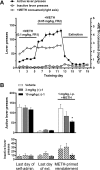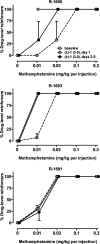Identifying Medication Targets for Psychostimulant Addiction: Unraveling the Dopamine D3 Receptor Hypothesis
- PMID: 25826710
- PMCID: PMC4516313
- DOI: 10.1021/jm501512b
Identifying Medication Targets for Psychostimulant Addiction: Unraveling the Dopamine D3 Receptor Hypothesis
Abstract
The dopamine D3 receptor (D3R) is a target for developing medications to treat substance use disorders. D3R-selective compounds with high affinity and varying efficacies have been discovered, providing critical research tools for cell-based studies that have been translated to in vivo models of drug abuse. D3R antagonists and partial agonists have shown especially promising results in rodent models of relapse-like behavior, including stress-, drug-, and cue-induced reinstatement of drug seeking. However, to date, translation to human studies has been limited. Herein, we present an overview and illustrate some of the pitfalls and challenges of developing novel D3R-selective compounds toward clinical utility, especially for treatment of cocaine abuse. Future research and development of D3R-selective antagonists and partial agonists for substance abuse remains critically important but will also require further evaluation and development of translational animal models to determine the best time in the addiction cycle to target D3Rs for optimal therapeutic efficacy.
Figures








Similar articles
-
Targeting the dopamine D3 receptor: an overview of drug design strategies.Expert Opin Drug Discov. 2016 Jul;11(7):641-64. doi: 10.1080/17460441.2016.1185413. Epub 2016 May 30. Expert Opin Drug Discov. 2016. PMID: 27135354 Review.
-
Current Perspectives on Selective Dopamine D3 Receptor Antagonists/Partial Agonists as Pharmacotherapeutics for Opioid and Psychostimulant Use Disorders.Curr Top Behav Neurosci. 2023;60:157-201. doi: 10.1007/7854_2022_347. Curr Top Behav Neurosci. 2023. PMID: 35543868 Free PMC article.
-
Medication discovery for addiction: translating the dopamine D3 receptor hypothesis.Biochem Pharmacol. 2012 Oct 1;84(7):882-90. doi: 10.1016/j.bcp.2012.06.023. Epub 2012 Jul 3. Biochem Pharmacol. 2012. PMID: 22781742 Free PMC article. Review.
-
Neuronal Dopamine D3 Receptors: Translational Implications for Preclinical Research and CNS Disorders.Biomolecules. 2021 Jan 14;11(1):104. doi: 10.3390/biom11010104. Biomolecules. 2021. PMID: 33466844 Free PMC article. Review.
-
Characterization of the transport, metabolism, and pharmacokinetics of the dopamine D3 receptor-selective fluorenyl- and 2-pyridylphenyl amides developed for treatment of psychostimulant abuse.J Pharmacol Exp Ther. 2010 Jun;333(3):854-64. doi: 10.1124/jpet.109.165084. Epub 2010 Mar 12. J Pharmacol Exp Ther. 2010. PMID: 20228156 Free PMC article.
Cited by
-
Effects of Acute and Chronic Treatments with Dopamine D2 and D3 Receptor Ligands on Cocaine versus Food Choice in Rats.J Pharmacol Exp Ther. 2017 Jul;362(1):161-176. doi: 10.1124/jpet.117.241141. Epub 2017 May 4. J Pharmacol Exp Ther. 2017. PMID: 28473458 Free PMC article.
-
2016 Philip S. Portoghese Medicinal Chemistry Lectureship: Designing Bivalent or Bitopic Molecules for G-Protein Coupled Receptors. The Whole Is Greater Than the Sum of Its Parts.J Med Chem. 2020 Mar 12;63(5):1779-1797. doi: 10.1021/acs.jmedchem.9b01105. Epub 2019 Sep 24. J Med Chem. 2020. PMID: 31499001 Free PMC article.
-
Biased Signaling Agonists of Dopamine D3 Receptor Differentially Regulate the Effects of Cocaine On Dopamine Transporter Function.ACS Chem Neurosci. 2025 Jul 16;16(14):2579-2591. doi: 10.1021/acschemneuro.5c00076. Epub 2025 Jun 26. ACS Chem Neurosci. 2025. PMID: 40570201 Free PMC article.
-
Dopamine D3 receptor antagonist reveals a cryptic pocket in aminergic GPCRs.Sci Rep. 2018 Jan 17;8(1):897. doi: 10.1038/s41598-018-19345-7. Sci Rep. 2018. PMID: 29343833 Free PMC article.
-
The novel dopamine D3 receptor antagonists/partial agonists CAB2-015 and BAK4-54 inhibit oxycodone-taking and oxycodone-seeking behavior in rats.Neuropharmacology. 2017 Nov;126:190-199. doi: 10.1016/j.neuropharm.2017.09.007. Epub 2017 Sep 6. Neuropharmacology. 2017. PMID: 28888944 Free PMC article.
References
-
- Newman A. H.; Grundt P.; Nader M. A. Dopamine D3 receptor partial agonists and antagonists as potential drug abuse therapeutic agents. J. Med. Chem. 2005, 48, 3663–3679. - PubMed
-
- Feng Z.; Hou T.; Li Y. Structure-based drug design for dopamine D3 receptor. Comb. Chem. High Throughput Screening 2012, 15, 775–791. - PubMed
-
- Newman A. H.; Grundt P.; Cyriac G.; Deschamps J. R.; Taylor M.; Kumar R.; Ho D.; Luedtke R. R. N-(4-(4-(2,3-Dichloro- or 2-methoxyphenyl)piperazin-1-yl)butyl)heterobiarylcarboxamides with functionalized linking chains as high affinity and enantioselective D3 receptor antagonists. J. Med. Chem. 2009, 52, 2559–2570. - PMC - PubMed
Publication types
MeSH terms
Substances
Grants and funding
LinkOut - more resources
Full Text Sources
Other Literature Sources
Medical

